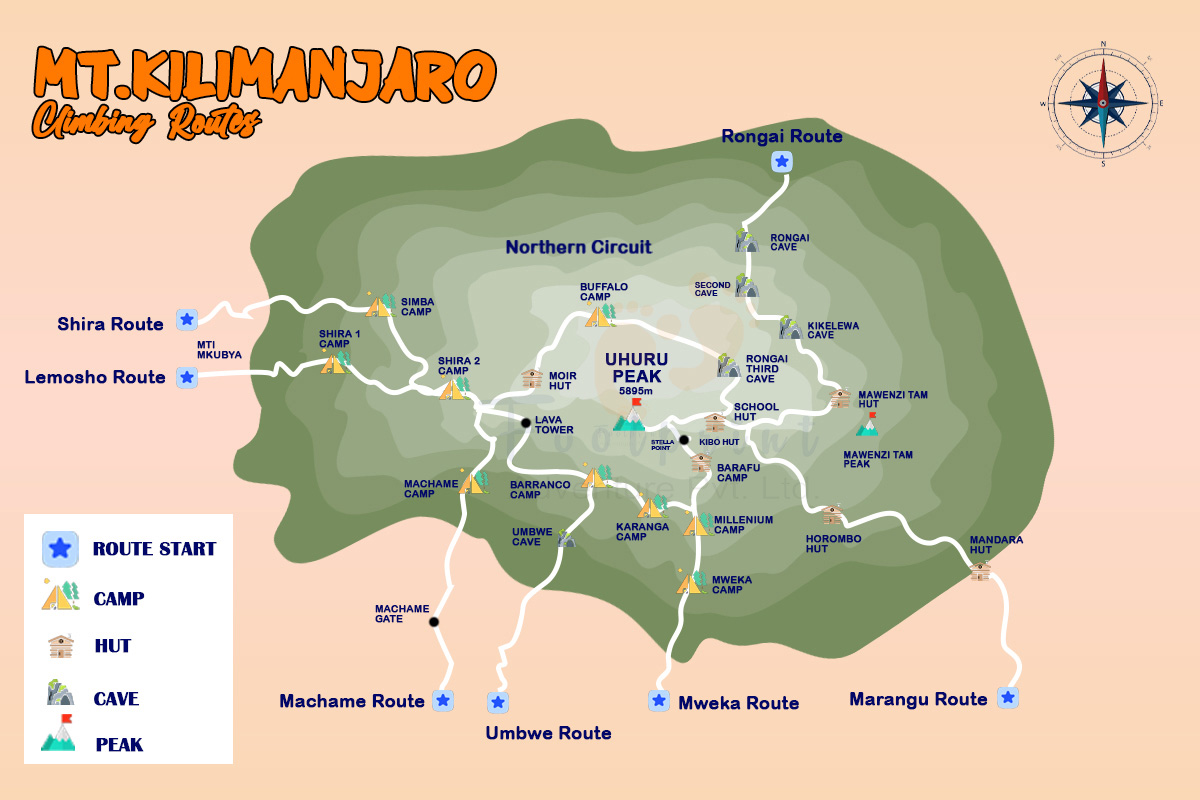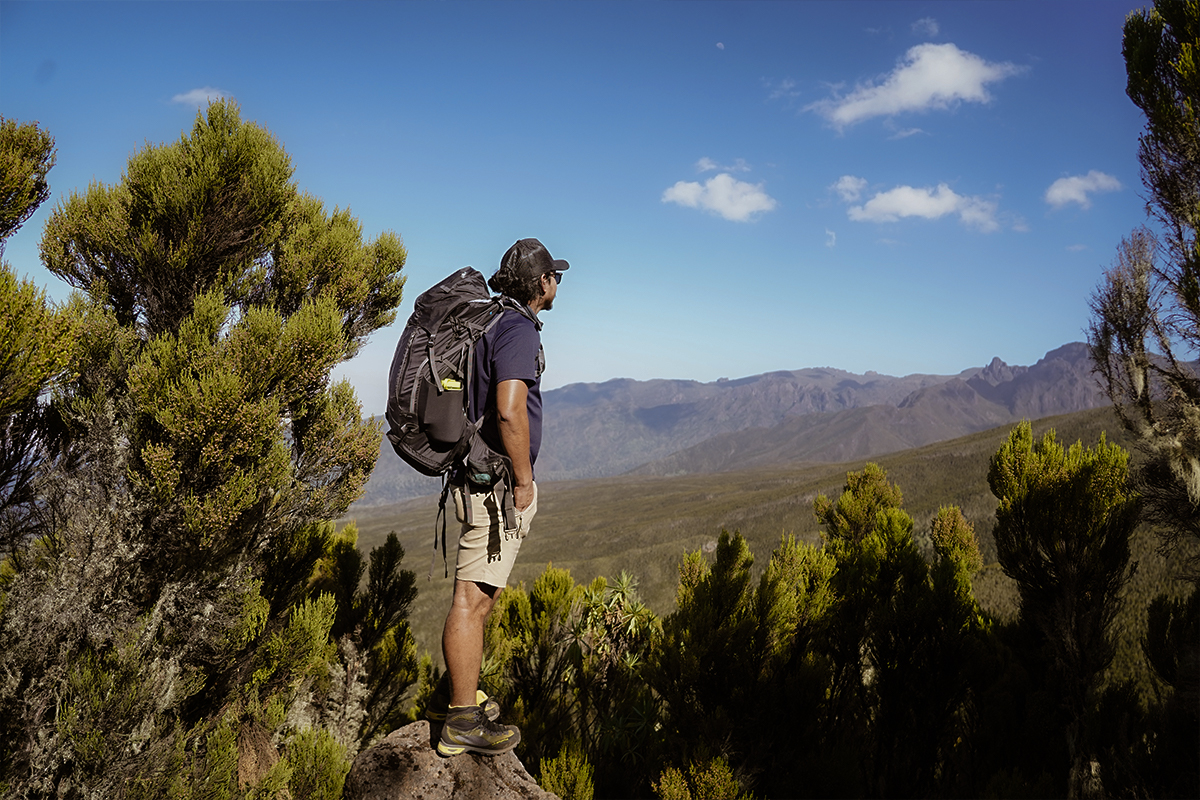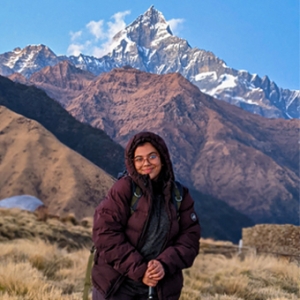Tallest Freestanding Peak in the world
Mount Kilimanjaro, a majestic stratovolcano located in Tanzania, is also the tallest freestanding peak in the world. Rising dramatically from the surrounding plains, Mount Kilimanjaro stands as a solitary giant, distinct from traditional mountain ranges, making it a unique geological marvel.
Unlike many other tall mountains which are part of mountain ranges or situated close to other peaks, Kilimanjaro stands alone. It is not part of any mountain range but rather an isolated stratovolcano. This isolation makes it unique among the tallest peaks, giving it the distinction of being the tallest freestanding mountain in the world.

The unique geological history of Kilimanjaro contributes to its freestanding nature. Kilimanjaro's formation is distinct from that of other tall mountains. It is a stratovolcano composed of multiple layers of hardened lava, volcanic ash, and other volcanic materials. Over millions of years, successive eruptions built up the mountain's massive cone shape. Its distinctiveness as a freestanding peak is due to its solitary presence on the Tanzanian plains.
Kilimanjaro is a Volcanic Mountain with 3 Major Summit Cones
Kilimanjaro is a volcanic mountain by which its origin has shaped its diverse landscapes, including glaciers, forests, and alpine deserts, making it a UNESCO World Heritage Site and a popular destination for climbers and adventurers. Kilimanjaro is composed of several cones and vents, with the main summit area featuring three volcanic cones. They are:
1. Shira
The Shira cone is the oldest of Kilimanjaro's volcanic cones, estimated to be around 500,000 years old. It is located on the western side of the mountain and is now largely eroded. Shira's caldera is visible on the plateau to the west of Kilimanjaro's main summit.
2. Mawenzi
Mawenzi is the second-highest peak on the mountain. It is located to the east of the main summit, Uhuru Peak. Mawenzi is characterized by rugged peaks, dramatic cliffs, and deep gorges, making it a challenging terrain for climbers.
3. Kibo
Kibo is the highest of Kilimanjaro's volcanic cones and is home to the main summit, Uhuru Peak, which stands at 5,895 meters (19,341 feet) above sea level. Kibo is considered dormant rather than extinct, and its last eruption is estimated to have occurred over 360,000 years ago.
While Mawenzi and Kibo are the most prominent cones, Kilimanjaro's volcanic activity has also formed other smaller cones and vents across its slopes. These include the subsidiary peaks of Shira, such as Shira Cathedral and Shira Needle, as well as numerous parasitic cones and lava flows.

History of Kilimanjaro
Kilimanjaro, lying in Kilimanjaro National Park, a UNESCO World Heritage Site, boasts a geological history that spans millions of years, characterized by volcanic activity and dynamic processes. The formation of Kilimanjaro is said to have begun with the eruption of its oldest volcanic cone, Shira, approximately 750,000 years ago. Over time, successive eruptions of lava, ash, and volcanic debris built up the mountain's massive cone-shaped structure. As magma rose from the Earth's mantle through weak points in the crust, it erupted onto the surface, gradually forming layers of solidified lava and volcanic rock. These layers, along with deposits of ash and other volcanic materials, contributed to the gradual growth of Kilimanjaro's towering summit.

7 Official Routes to summit Mount Kilimanjaro
Climbing Mount Kilimanjaro offers several official routes, each varying in difficulty, duration, and scenery. These routes are managed by the Tanzanian National Park Authority and provide climbers with diverse experiences as they ascend Africa's tallest peak. Here are the seven official routes to summit Mount Kilimanjaro:
1. Marangu Route (Coca-Cola Route)
The Marangu Route for Kilimanjaro Climb also known as the "Coca-Cola Route," stands out as the easiest route to the summit of Kilimanjaro. Spanning approximately 5 to 6 days, it caters to climbers of all physical fitness, making it popular among beginners.
The route is marked by well-maintained trails that wind through lush rainforests and scenic landscapes. Unlike other routes, climbers get to rest in huts with basic amenities instead of camping, adding a touch of comfort to the journey. However, its popularity can result in crowded conditions during peak climbing seasons.

2. Machame Route (Whiskey Route)
Known as the "Whiskey Route," the Kilimanjaro Climb Via Machame Route presents a more challenging yet rewarding route to Kilimanjaro Summit. Over 6 to 7 days, climbers navigate through diverse terrains, including rainforests, heath, and alpine deserts, offering breathtaking vistas along the way. Camping under the stars at designated campsites adds to the adventure, attracting enthusiasts seeking a more immersive experience of Kilimanjaro's natural beauty.
3. Lemosho Route
The Kilimanjaro Climb Via Lemosho Route stands out as the most scenic splendor with gradual ascent profile, making it a preferred choice for climbers seeking solitude and better acclimatization. Stretching over 7 to 9 days, this route offers panoramic views of Kilimanjaro's pristine wilderness, from lush rainforests to barren alpine deserts. Camping in tents at designated campsites allows climbers to immerse themselves in the rugged beauty of their surroundings, away from the crowds.
4. Shira Route
The Shira Route offers a challenging yet exhilarating climb, beginning with a steep ascent through the Shira Plateau. Taking over 7 to 9 days, climbers traverse through diverse landscapes, from rugged plateaus to alpine deserts, enjoying unparalleled views of Kilimanjaro's western slopes. Despite its demanding terrain, the route promises a remote wilderness experience, away from the hustle and bustle of other trails.
5. Rongai Route
Situated on the Northern Side, the Rongai Route offers a quieter and less crowded alternative to the southern routes to Mount Kilimanjaro. Spanning from 6 to 7 days, climbers trek through lush rainforests and open moorlands, enjoying unique views of the Kenyan plains. Camping under the stars at designated campsites enhances the sense of adventure, offering a serene retreat amidst Kilimanjaro's tranquil wilderness.

6. Northern Circuit Route
The Northern Circuit Route offers the longest and most comprehensive trek up Kilimanjaro, typically lasting 8 to 10 days. Beginning on the western side of the mountain, this route meanders through a variety of ecosystems, including rainforests, moorlands, and alpine deserts and takes a circuit to the northern side. Its extended duration allows for optimal acclimatization, enhancing climbers' chances of summit success. Moreover, the Northern Circuit Route provides unparalleled opportunities for solitude and reflection, as it is less frequented than other trails, offering a sense of exclusivity and connection with nature.
7. Umbwe Route
Renowned as the most challenging route on Kilimanjaro, the Umbwe Route presents a direct and steep ascent to the summit. Climbers embark on a rigorous journey through dense forests and rocky terrain, navigating steep inclines and narrow paths. The route's difficulty demands strong physical fitness and mountaineering skills, making it suitable for experienced climbers seeking a thrilling and demanding adventure. Despite its arduous nature, the Umbwe Route offers unparalleled views and a sense of accomplishment upon reaching the summit, making it a popular choice for those craving a true test of endurance and determination.
50% Summit Rate
Despite being considered one of the easiest of the Seven Summits to climb, Mount Kilimanjaro poses a major challenge to many trekkers due to its rapid altitude gain over a relatively short period. Every year, a large number of climbers fail to reach the summit, usually due to altitude sickness and physical exhaustion. The body may not be able to adjust to the rapid elevation rise experienced by climbers as they ascend Kilimanjaro's slopes, which can cause symptoms including headaches, nausea, and exhaustion. Regardless of comprehensive planning and physical preparation, many people continue to struggle with their capacity to adjust to thinner air. To avoid any high altitude-related issues, it is highly recommended to acclimatize in order to get used to the increasing altitude.
The diverse landscapes of Kilimanjaro, which range from luscious rainforests to harsh alpine deserts, only make the task more difficult and challenge the boundaries of human endurance and resilience. For detailed information on the Difficulty Level of Mount Kilimanjaro, visit here.

First recorded ascent and Fastest Ascent
The first recorded ascent of Mount Kilimanjaro dates back to 1889 when German geologist Hans Meyer, accompanied by Austrian mountaineer Ludwig Purtscheller and local guide Yohani Kinyala Lauwo, successfully reached the summit of Uhuru Peak on October 6th. Their expedition marked a significant milestone in mountaineering history, as it was the first documented ascent of Africa's tallest peak.
Regarding the fastest ascent of Mount Kilimanjaro, records vary depending on the route taken and individual capabilities. Karl Egloff, a Swiss-Ecuadorian athlete, holds the record for the fastest ascent and descent of Mount Kilimanjaro. Egloff set this remarkable achievement on August 13, 2014, completing the round trip via the Umbwe Route in an astonishing time of 4 hours, 56 minutes, and 24 seconds. His feat surpassed the previous record set by Kilian Jornet and demonstrated unparalleled speed and endurance in conquering Africa's highest peak. Egloff's accomplishment further showcases the remarkable capabilities of elite athletes and their ability to push the boundaries of human performance in extreme environments.
Has 5 different Climatic Zones
The 5 diverse climatic zones found at Mount Kilimanjaro result in varying altitudes, creating distinct ecosystems, each characterized by unique flora, fauna, and weather conditions. Generally, Kilimanjaro can be divided into 5 main climatic zones:
1. Cultivation Zone (800m - 1,800 m)
At the base of Mount Kilimanjaro lies the cultivated zone, where human activity shapes the landscape. Here, you'll find villages, farms, and plantations nestled in the fertile soils surrounding Kilimanjaro. The climate is typically warm and humid, conducive to agriculture, with rainfall supporting the growth of crops such as bananas, coffee, and maize.
2. Rainforest Zone (1,800m - 2,800 m)
As climbers ascend from the cultivated zone, they enter the lush rainforest zone, characterized by dense vegetation and abundant biodiversity. Towering trees, draped with mosses and epiphytes, create a verdant canopy that shades the forest floor below. The air is thick with moisture, and rainfall is frequent, sustaining a diverse array of plant and animal life.
3. Heath and Moorland Zone (2,800 m - 4,000 m)
Above the rainforest zone, the landscape transitions into the heath and moorland zone, where the vegetation becomes more sparse and shrubby. Giant lobelias, Senecio plants, and tussock grasses dominate the landscape, adapted to the cooler temperatures and thinner soils of higher elevations. The air is cooler and drier here compared to the rainforest zone, with temperatures dropping noticeably at night.

4. Alpine Desert Zone (4,000 m - 5,000 m)
Further up the mountain, climbers enter the alpine desert zone, characterized by barren landscapes and rocky terrain. Vegetation becomes increasingly scarce, giving way to vast expanses of loose scree and volcanic rocks. Harsh winds and extreme temperature fluctuations are common in this zone, with daytime temperatures often moderated by intense sunlight but dropping dramatically at night.
5. Arctic Zone (5,000 m - 5,895 m)
At the summit of Kilimanjaro, climbers reach the arctic zone, where glaciers and permanent snowfields dominate the landscape. The air is thin and frigid, with temperatures regularly dropping below freezing. Despite the challenging conditions, hardy organisms such as lichens and mosses manage to eke out a living in this harsh environment, adapting to the extreme cold and limited moisture.
These distinct climatic zones of Mount Kilimanjaro create a gradient of environments, each supporting its own unique ecosystems and species. Climbers ascending the mountain traverse through these zones, experiencing a dramatic change in scenery and climate as they journey towards the summit.
Shrinking Glaciers
The glaciers at Mount Kilimanjaro have long been iconic features of its summit, however, they are now rapidly shiring due to climate change. These glaciers, once vast and majestic, are retreating at an alarming rate, with some estimates suggesting they could disappear entirely within a few decades if current trends continue.
The glaciers of Kilimanjaro are primarily found on the slopes of its highest peak, Kibo, and are composed of ice formed from the accumulation of snow over thousands of years.
These glaciers have played a crucial role in shaping the mountain's landscape and have been a significant source of freshwater for surrounding ecosystems. However, rising temperatures and changing precipitation patterns have caused the glaciers at Kilimanjaro to melt at an unprecedented rate. Studies have shown that the glaciers have lost more than 80% of their volume since the late 19th century, and their surface area has decreased by nearly 75% since the 1912 measurements.
Furthermore, the loss of glaciers in Kilimanjaro has diminished the scenic beauty and cultural significance of the mountain, as they have been a focal point of the landscape for generations. Tourists and climbers who visit Kilimanjaro may witness firsthand the effects of climate change as they observe the shrinking glaciers and their impact on the mountain's ecosystem.

Conclusion
Lastly, Mount Kilimanjaro stands not only as a physical marvel but also as a symbol of our planet's fragility and resilience in the face of climate change. From its towering peaks to its shrinking glaciers, Kilimanjaro summarizes the beauty and challenges of our natural world.
Let Kilimanjaro be more than a destination of nature, as we marvel at its beauty and conquer its heights. Whether you dream of reaching the summit or simply reveling in its wonders from afar, Mount Kilimanjaro invites us all to appreciate the fragile yet resilient beauty of our planet. If you are also interested in Climbing Kilimanjaro, contact us here.











